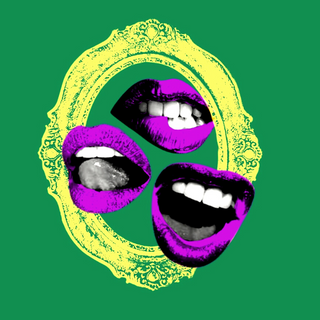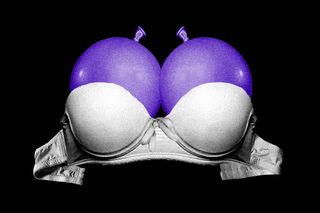
Large Breasts Have Been Sexualized – But the Pain of Having Them Remains Unspoken
Large breasts come with chronic pain. But a combination of sexualization, cultural norms around fertility and motherhood prevent help.

Approximately 15,000 women underwent breast reduction surgeries in 2021, a recent Times of India report revealed. “I always felt my body was out of shape because of my breasts, and it made me very conscious. I had developed a stoop, I lacked confidence and chose to swim only when I was the only one in the pool,” a 31-year-old corporate lawyer told TOI. This isn’t uncommon; the effects of large breasts which women face are rarely discussed: over-sexualisation regardless of clothing; accusations of immoral behavior; and chronic body pain. Although more than 30,000 women received breast implants according to the report, breast reduction procedures may slowly be catching up. A combination of severe physical and psychological issues lead women to opting for fat and glandular tissue removal surgeries, while others choose breast lifts. “Reduction,” according to Dr. Devyani Barve, a plastic surgeon in Mumbai “is often a necessity for some Indian women, especially those whose breast size is not proportional to the rest of their body. These women tend to lean forward or slouch, and develop lower back pain.” Beast reductions are seeing an upward trend, and many women also spend significant money on ‘alternative options’, Dr. Barve told TOI — firming creams, hormonal pills, and steroids.
Yet, the awareness and access of these surgeries remain fraught for a multitude of reasons: cost, lack of medical coverage, social stigma, and the cultural emphasis of breasts as symbols of fertility. In her paper “Worshipping Breasts in the Maternal Landscape of India”, historian Anannya Bohidar discusses how the female breast is an important motif in Hindu Brahmanical worship, present in both anthropological and archaeological contexts throughout the subcontinent. “[T]heir role as potent talismans, symbols of maternity, empowerment, and eroticism,” writes Bohidar, ensures that breasts are a constant in all aspects of a woman’s life, most especially in marriage and motherhood. While for many this prominence is inspiring and empowering—a sign that the Western ideal of physical beauty, which has long emphasized thinner and thinner women, has no true place in Indian culture — for those with large breasts, it brings pain.
In addition to the psychosocial effects, large breasts have significant health impacts. A study in The Open Orthopaedics Journal stated that neck, shoulder, and back pain were part-and-parcel of a heavy chest, as women experience persistent pain from pulled-back shoulders and hunched backs. These lead to poor posture and later, persistent pain. The lack of available and adequate underwear support also contributed to shoulder grooves and thoracic pain. Rashes (especially under the breasts), numbness (including of the hands and fingers), and an inability to exercise and shortness of breath are all symptoms. The risk of cancer also increases as breast density does, and it’s not an issue resolved by diet, exercise, and clean living. For many women, especially in India, breast conditions are genetic and barring a life of perpetual pain, surgery is the only option. But despite a rise in the surgeries, they remain culturally taboo — leading to delays, more pain.
Dr Lokesh Kumar, president of the Plastic Surgeons Association, attributes the rise of breast reduction surgeries and other cosmetic procedures in India to a multitude of reasons: a rising economy leading to more disposable income, modernization, and influence from the West. Yet, this attitude is in stark contrast with the conservative precepts, which scorn plastic surgery as superficial or materialistic. “It’s expected that at the age of 60 or 65, you should not spend your money on getting more beautiful, because you are already past your prime,” plastic surgeon K.M. Kapoor told SFGate. These taboos lead to patients lying to their friends and family about receiving such surgeries, especially when they can be forbidden from having them.
Related on The Swaddle:
Earlier, Dr. Barve told The Swaddle about a 38-year-old patient suffering from gigantomastia (a rare condition where excessive tissue growth leads to extremely large breasts) who then developed obstructive sleep apnea—the weight of her breasts would impact her breathing and consequently, disturb her sleep. Even though the patient and her husband were onboard and eager to have the relevant procedure, the patient’s mother wasn’t. “She said: ‘[T]his is something I have lived with, so many ladies I know have lived with all their life—this is not something you undergo surgery for’,” Dr Barve-Venkat said, sharing the mother’s words. “‘You’re just scarring yourself for no reason, so I am not going to support you.’” The couple were pressured into canceling the procedure after involvement from the whole family.
Since adolescence, Delhi-resident Shiva Shukla suffered from gigantomastia. Growing up in a conservative household where the discussion of private parts was taboo and facing constant unwanted gazes from men and women alike, Shukla’s self-confidence corroded as her physical pain escalated. “At times I tried to share my ordeal with my mother … but nobody paid any attention or considered it a malaise … Not only that, most family members would tell me that I should consider myself lucky as I had been liberally endowed,” Shukla shared with Indian Express. The only medical advice she received was “to exercise regularly and keep [my] body fit”—advice which fell flat as age and hormonal changes made her condition worse. After marriage, Shukla had to grapple between motherhood or a life free of pain, due to the perception that the breast reduction surgery her husband had told her about would affect her ability to breastfeed. Following childbirth, however, Shukla finally underwent the four-hour surgery, removing about 1.5kg of tissue from each breast, and woke up looking forward to a pain-free future. “My shoulders are relieved … [M]y back doesn’t ache anymore.”
Societal restrictions and taboos have led to the popularity of alternative forms of treatments like firming creams, hormonal pills, and steroids, and are furthered by a lack of awareness surrounding breast reduction surgeries. Botox is also seen as a nonsurgical substitute for breast lifts, but it comes with the normal complications: bruising, soreness, swelling, and even allergic reactions. However, little to no research has been found attesting to the efficacy or safety of these methods, and thus, there is a danger in using these proxies, especially without proper medical guidance. For those with serious conditions like gigantomastia, invasive surgeries like breast reduction are the only true option.
The attitude of interference, judgment, and prohibition is abjectly common in India, especially when concerning a woman’s decision regarding her own physical health. Such maladies are underrepresented and their severe physical impact minimized—after all, both socially and medically, women’s pain has a history of being underestimated and cited as “just a symptom of being female”. It is no surprise, therefore, that within the Indian sociocultural context, the notion of suffering is inherent to womanhood—one that is further perpetuated by the enduring cultural emphasis linking breasts, fertility, and womanhood.
Akankshya Bahinipaty writes about the intersection of gender, queerness, and race, especially in the South Asian context. Her background in political science and communication have shaped her past multimedia and broadcasting experience, and also her interest in current events.
Related


Body Dysmorphic Disorder Is on the Rise; Here’s What You Need to Know About It
